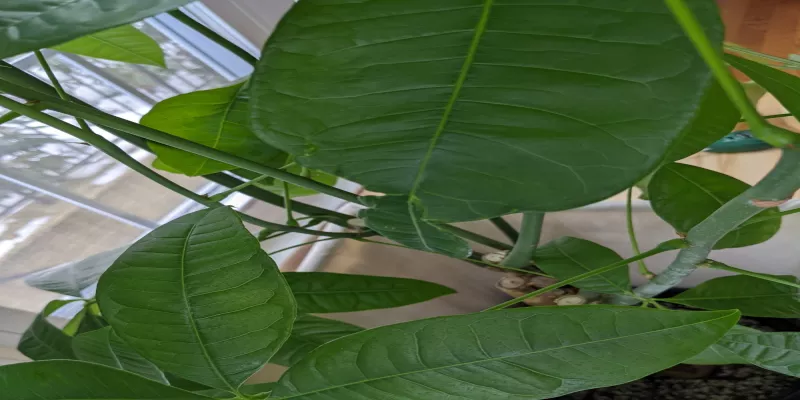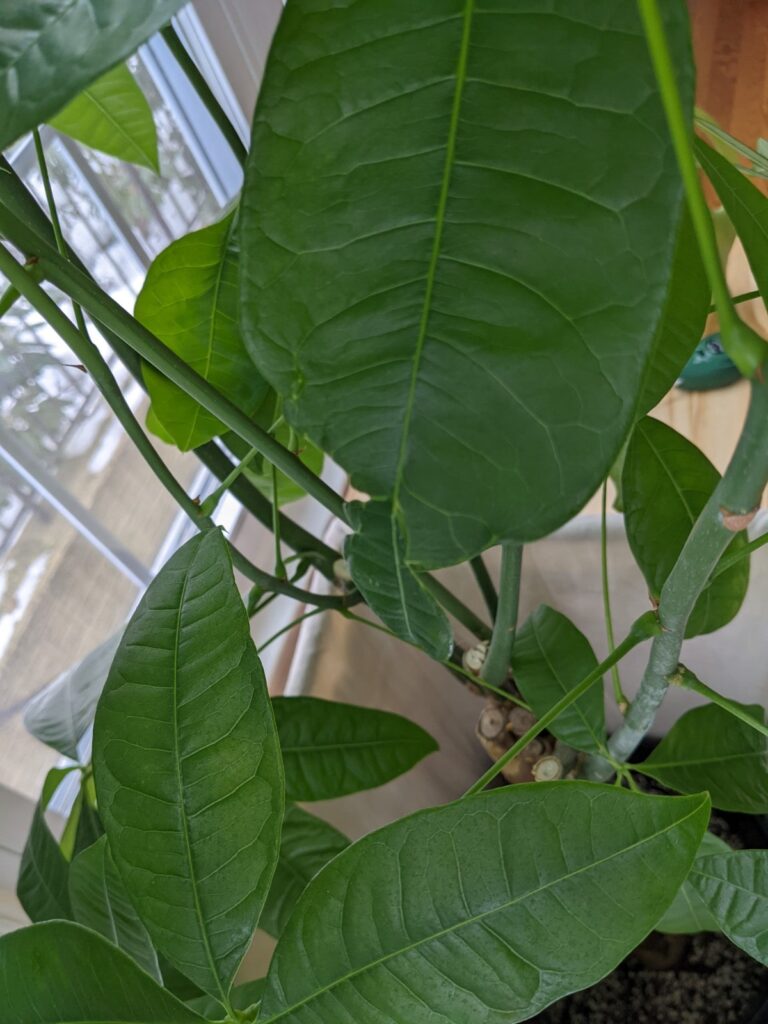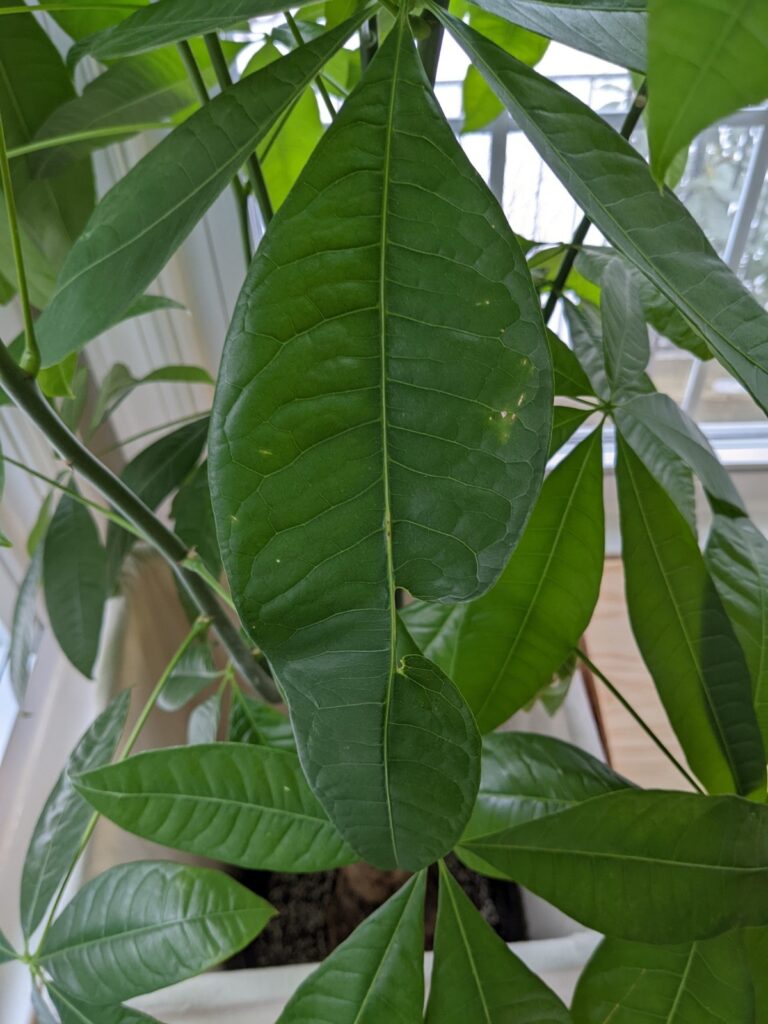Money Tree Leaves Problems

Money Trees, or Pachira Aquatica, are popular house plants. They're often sold as several plants braided together in one single pot. The leaves grow five or six on a stem. People buy house plants because they add an element of the outdoors with their beautiful foliage. In this post, I'll go over some of the more common Money Tree leaves problems and what you can do to fix them.
Money Tree Leaves Issues
Watering Issues
Watering issues for Money Trees can present in several ways. The leaves may begin to turn yellow or brown. The leaves may become droopy. Are Money Tree leaves drying out? Or maybe your Money Tree is dropping leaves. These are all possible signs of over or underwatering.
First I'll address overwatering. An overwatered Money Tree can display all of the symptoms listed above. Although, the leaves are unlikely to dry out before you see yellowing or drooping if that makes sense. How do you tell if you have overwatered your Money Tree? You can stick your finger in the soil to see if it feels wet. Does your pot have drainage holes that excess water can escape through? You can also carefully lift your plant out of its pot to examine the soil and roots. This is how you will really assess the damage of an overwatered plant. If the roots have begun to rot, which is evident by dark and squishy roots, then you will need to root prune, repot, and hope for the best. I have a whole post on salvaging an overwatered plant.
An underwatered Money Tree can also be represented by all of the leaf problems I mentioned above. How helpful, right? I'll try to help more. Just like above, you want to check your soil moisture. You can do that with your finger or if you want to be more precise use a soil moisture meter. It really should be included in your regular watering regimen. Check the soil moisture before you water this will help prevent you from overwatering, but will also give you a better idea of how quickly your plant is drying out to prevent underwatering as well.
Nutrient Issues
Fertilizing issues can also cause your Money Tree leaves problems. If you have fertilizer issues, some visible signs you might see from your Money Tree will be yellowing leaves or even deformed leaves. You can see an example of a deformed Money Tree leaf below, where the tip of the leaf at the top of the photo doesn't look good. Both over-fertilizing and under-fertilizing can cause issues

Most plant fertilizers contain different ratios of the macro-nutrients n-p-k, nitrogen, phosphorus, and potassium. Where nitrogen primarily promotes leaf growth, phosphorus promotes root development and budding/fruiting, and potassium is for overall health. If you're experiencing leaf issues it may be that you are deficient or too abundant in nitrogen. Depending on your issue and the severity you may need different ratios of fertilizer to fix the issue. They make high nitrogen fertilizers, low nitrogen fertilizers, and balanced fertilizers.
It's difficult to tell whether you have been over or under-fertilizing. You can go based on whether you have been following the fertilizer instructions completely. There should be very specific instructions on dilution, dosage, and frequency of fertilization. The only real way to know is to test your soil though. These soil rapitests are convenient for that. They are relatively cheap and give you a definitive answer about your soil nutrients.
Pest Issues
Pest issues may also cause your Money Tree leaves some problems. Damage from pests will show up as leaf discoloration, typically yellowing, but it will be more splotchy. Generally speaking, pests feed on plant matter so you might notice small spreads of yellow dots. If pests are feeding on your Money Tree you might also see leaves drooping or even small holes in leaves. If you see actual bugs or tiny webs, you definitely have a pest problem.
A number of pests can attack your indoor Money Tree. The most common are pests like aphids, spider mites, scale, and mealybugs. Look under your leaves for aphids, scale, and mealybugs. Spider mites make small webs and often collect around the petiole, leaf tip, and underside of the leaves.

If you notice or suspect that you have pests, you should move your plant away from other plants as soon as possible. Pests are good at hopping plants. Next, you want to do your best to remove the pests you can see. For aphids and spider mites, you can try spraying your plant off with a hose outside or in the shower. Be careful not to completely soak the soil to the point that you end up in an overwatering situation. Scale and mealybugs have to be removed more manually people typically use alcohol on a cotton swab to do so. Next, you want to treat your plant with some kind of pest control. Organic solutions like neem oil work as well as non-organics like insecticidal soaps. The key is to follow the instructions, which may seem like overkill, but it's important to treat your plant for weeks because of the lifecycle of these types of pests.
What Happens After You Fix the Problem
The great thing about Money Trees is that they are a very resilient plant. If you have Money Tree leaf problems, this post will help you fix them. In the long run, your Money Tree will bounce back and grow beautiful and bushy. And if your Money Tree is looking kind of scraggly because of the problems don't hesitate to prune away the bad areas. I have a step-by-step tutorial from the last time I did a big prune of my Money Tree.
Add new comment